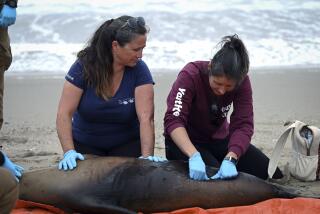Santa Rosa Island Wild Swine Hunt Gathers Momentum
- Share via
SANTA ROSA ISLAND — Professional hunters and National Park Service employees have killed nearly 1,000 wild pigs on this rugged island 25 miles off the Santa Barbara coast in a campaign to eliminate the voracious intruders, which threaten rare native plants.
The pig hunt is the first step in fulfilling a congressional mandate to protect and restore the vegetation of Santa Rosa, one of five islands in the Channel Islands National Park.
“We are going to get 99% of them on this first go-around,” said Wayne Long, a Northern California professional hunter whose firm is being paid $310,000 by the National Park Service to kill every pig on the island.
Long’s hunters joined a government-ordered kill March 6 by sweeping in with helicopters, shooting pigs from the air. Now, a team of five sharpshooters continues the hunt on the ground, rising before dawn every day to scour the canyons of the 84-square-mile island for an estimated 300 swine.
National Park Service biologists say they have killed about two-thirds of the pigs, which were brought to the island by ranchers in the 1850s.
The National Park Service blames the black-and-tawny, 100-pound swine for endangering the island’s rarest plants, including the Island Oak that is found only on Santa Rosa and Santa Cruz Islands.
Biologists say the wild pigs have toppled trees and ripped apart Chumash Indian burial grounds by rooting for grubs and acorns.
Yet, the killing of the pigs has been a delicate undertaking for a federal agency most familiar with the conservation of natural resources.
Until this week, the Park Service offered few details about the pig hunt. On Monday, park employees showed reporters and photographers the devastation wrought by pigs on the island and disclosed that most of the killings had occurred.
So far, the killing has raised only a mild protest from an animal rights group.
“Sure they’re destructive; they’re pigs,” said Melissa O’Brien, who joined the island tour as a representative of Concerned People for Animals of Simi Valley. “But they didn’t want to come out here. They were brought here. For that, they don’t deserve to die.”
O’Brien’s group has suggested neutering the pigs or building fences to restrict them to less ecologically fragile parts of the island. Others have proposed ferrying the pigs to the mainland, either to be butchered for food or set free in the wild.
The U. S. Department of Agriculture will not allow the island pigs to be brought to the mainland alive because they carry a herpes virus that could spread to domestic swine. Park Service officials said it would be unfeasible to set up a makeshift meat packing plant to process the pork.
Park Service officials also said they believe rounding up the skittish pigs would be too costly or might not work. Given their short gestation period and litters of up to eight piglets, Channel Islands National Park Supt. C. Mack Shaver said, “We could take 80% of the pigs a year and we wouldn’t reduce their numbers at all.”
The Park Service bought the island in 1986 for $29 million, with a 25-year agreement to allow the previous owners--Vail & Vickers Ltd. of Santa Barbara--to use island grassland to run about 2,000 head of cattle, 1,000 mule deer and 400 elk.
Carmen A. Lombardo, a Park Service biologist, said the cattle, deer and elk also harm the native vegetation. Park officials are negotiating a range management plan with the ranchers, but cannot expel the animals until the lease expires.
Lombardo said the drought had greatly reduced the number of pigs from a high of about 4,000 five years ago.
More to Read
Sign up for Essential California
The most important California stories and recommendations in your inbox every morning.
You may occasionally receive promotional content from the Los Angeles Times.










